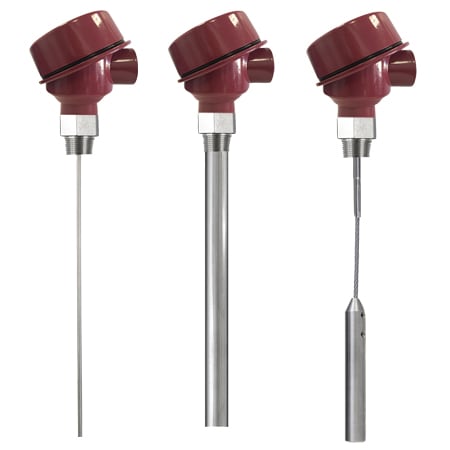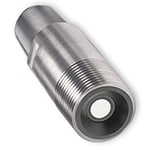Measuring and monitoring fluid levels accurately and precisely requires choosing the correct methodology for the target medium and vessel. Generally, you will choose among six methods for measuring and monitoring fluid levels, each with advantages and disadvantages:
- Continuous float level transmitters
- Differential pressure transmitters
- Load cells
- Radar level transmitters
- Radio Frequency (RF capacitive level transmitters)
- Ultrasonic level transmitter
Continuous Float Level Transmitters
 Float Level Transmitter
Float Level Transmitter
These level monitors operate by using a float suspended in or on the fluid from a rod, something of a dip-stick, which sends a vibration up the rod to a sensor.
There are two main types. In Magnetostrictive designs, the float carries a magnet which disrupts the electrical pulse sent down the rod from the sensor. The return vibration (strain pulse) is timed and the level of the float determined.
Resistive Level Sensors utilize the same rod and magnetic float set-up; however, now, the rod contains reed switches with resistors. As the float rises and falls, these switches close and change the resistance of the circuit. The resistance indicates the float position to the sensor.
A second set of floats and sensors can be installed to measure levels of two different fluids. For example, if you wanted to check an underground storage tank for water leakage, two sensors could be used to determine if one fluid (oil) was floating on a second fluid (water).
These measurements are accurate. One advantage to the float measurement is accuracy in foamy media. Non-contact technologies, like ultrasound, may give false readings under these conditions.
Requiring contact, however, leads to disadvantages. You may not desire contacting the medium. The materials in your rod or floats may not be compatible with the medium. Temperature and buoyancy issues may alter the accuracy of the results. Finally, the displacement of the floats and rods in much smaller vessels may drive imprecise results.
Continuous float level transmitters are appropriate and accurate for typical applications.
Differential Pressure Transmitter
 Differential Pressure
Differential Pressure
Widespread use in many applications, differential pressure transmitters can be used to determine fluid levels by determining the difference in head pressure between the low pressure port and the high pressure port in its usual configuration.
The difference in pressure becomes an output signal which is calibrated to indicate a fluid level.
Load Cells
 Miniature Metric Load Cell
Miniature Metric Load Cell
A load cell is a transducer technique that measures weight, a mechanical force or a load, and creates an output signal which relays data to be extrapolated into a fluid level.
These technologies range from very inexpensive off the shelf to custom designed, and easy to install, from readily available to complicated. Your application will determine appropriateness and cost-effectiveness.
Fluid monitoring is usually on the lower end of complexity. The force is one-directional, static and repetitive.
Temperature variance and the issues with contact technologies apply.
Radar Level Transmitters
 Guided Wave Radar Level Transmitter
Guided Wave Radar Level Transmitter
Radar is a non-contact method that entails bouncing an electromagnetic pulse off a fluid surface and measuring the time required for the pulse to return to the sensor.
The quicker the pulse returns, the higher level the fluid.
The contact-free measurement has advantages in that media characteristics are not as restrictive. Radar works best in metal vessels though. The vessel may restrict certain media from using this technology.
Highly corrosive media, for example, would not be stored in a steel vessel. Radar may not be the best choice for this reason.
Radar sensing technology requires some installation time. The software must be installed so you can calibrate the equipment.
Calibration eliminates false echoes from inside the vessel.
These restrictions and calibrations imply another issue with radar: portability. If your application requires measuring many tanks or a more dense fluid below a floating level, radar may not be your best choice.
Radar sensors can be used when the process materials are flammable or dirty and when the composition or temperature of the vapor space varies. For example a beer brewery vat, where the characteristics of the air in the vessel are going to change as the yeast works to release more CO2 forming a head or foam layer. In this application, any other type of sensor is not going to work.
Radio Frequency (RF) Capacitance
RF technology uses electrical characteristics of capacitors in a vessel to map the contours of the surface area. Yes, contours.
This technology, then, can be used in determining the levels of granules, slurries, even fluids with differing densities.
The apparatus is similar to the continuous float level probe. Rather than attaching magnets, the vessel wall often serves as the second conductor. This method defines the area of interest, the inside of the vessel, shared by the two conductors. The volume will ultimately be defined as the sum of these areas along the probe.
The technology is based on electrical capacitance, that is, the ability for a conductor to store an electrical charge, exists between two conductors. This capacitance is also affected by the medium, the non-conducting fluid or material to be measured.
Air has a minimal effect on the capacitance of the probe and vessel wall. Different fluids and materials have relatively high insulating characteristics.
As the probe measures increased insulating properties compared to air, it signals fluid or material at that level. It also signals the relative amount of insulating property, which might indicate uneven distribution at the surface.
One disadvantage using this technology is fluid build-up on the probe. False level readings may occur without proper maintenance and cleaning.
Configuring the correct probe and vessel is important for the application. Custom designs that will work for your application are available.
Ultrasonic Liquid Level Sensors and Transmitters
 Ultrasonic Distance and Level Sensor
Ultrasonic Distance and Level Sensor
Similar to radar, Ultrasonic sensors are less sensitive to medium characteristics and vessel construction. It is virtually a point and shoot technology for fluid levels where one reading will do.
Since it is a no contact technology, acids, printing chemicals, even waste water can be easily measured.
Slurries and foamy fluids can decrease the accuracy of this technology without designing a more sophisticated process for data collection.

